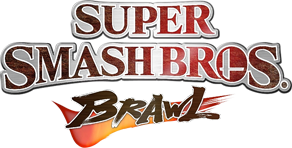m (→Characters: Added Character Select Screen and made minor corrections) |
mNo edit summary |
||
| Line 77: | Line 77: | ||
*[[Super Smash Bros. Brawl/Pikachu|Pikachu]] | *[[Super Smash Bros. Brawl/Pikachu|Pikachu]] | ||
*[[Super Smash Bros. Brawl/Pit|Pit]] | *[[Super Smash Bros. Brawl/Pit|Pit]] | ||
*[[Super Smash Bros. Brawl/ | *[[Super Smash Bros. Brawl/Pokémon Trainer|Pokémon Trainer]] | ||
**[[Super Smash Bros. Brawl/Squirtle|Squirtle]] | **[[Super Smash Bros. Brawl/Squirtle|Squirtle]] | ||
**[[Super Smash Bros. Brawl/Ivysaur|Ivysaur]] | **[[Super Smash Bros. Brawl/Ivysaur|Ivysaur]] | ||
**[[Super Smash Bros. Brawl/Charizard|Charizard]] | **[[Super Smash Bros. Brawl/Charizard|Charizard]] | ||
*[[Super Smash Bros. Brawl/R.O.B.| | *[[Super Smash Bros. Brawl/R.O.B.|Rob]] | ||
*[[Super Smash Bros. Brawl/Samus|Samus]] | *[[Super Smash Bros. Brawl/Samus|Samus]] | ||
*[[Super Smash Bros. Brawl/Sheik|Sheik]] | *[[Super Smash Bros. Brawl/Sheik|Sheik]] | ||
Revision as of 17:20, 17 April 2012

Super Smash Bros. Brawl
Super Smash Bros. Brawl is the highly-anticipated third installment to Nintendo's popular Super Smash Bros series. It adds a few new characters to the roster including third parties such as Snake and Sonic, while dumping a few old ones. This game features a lot of new content, such as a large-scale story mode called the Subspace Emmisary and lots of collectibles including trophies, stickers and CDs. It also has one of the largest music libraries in any videogame, featuring original versions and new arrangements of famous songs throughout Nintendo history rearranged by 38 renowned video game composers. However, it has been criticised by a lot of competitive players due to it's slower engine, drastically reduced hitstun, removal of useful advanced techniques, unbalanced gameplay, mediocre online capabilities, cheap techniques like chaingrabs and tripping.
Controls and Terminology
There are tons of different terms used in Smash to describe the plethora of techniques that it can be confusing even for experienced players. Here you will not only read about the controls but the terminology used by Smash players.
System Guide
This guide shall tell you how everything in Super Smash Bros. Brawl works. Every technical aspect will be discusses in this portion of the guide.
Basic Elements
This section covers the most basic elements of Brawl that you may also find in other fighting games.
Universal Abilities
These are the abilities shared by every character in the game. This include basic abilities such as dashing and shielding.
- Basic Movement
- Shielding
- Perfect Shielding
- Dodging
- Standard Attacks
- Special Attacks
- Wakeup and Recovery
- Grabbing and Throws
- Teching
- Directional Influence
- Taunting
- Item Usage
- Final Smash
Game Systems
This section covers the rules and physics of Brawl.
Characters
Stages
Stages are a unique feature in the Smash series as they're not only a change in scenery, but a gameplay affecting factor in a match. Read about them below.
General
Starter
- Battlefield
- Castle Siege
- Final Destruction
- Lylat Cruise
- Pokémon Stadium (Melee)
- Smashville
- Yoshi's Island
Counterpick
Banned
- 75m
- Big Blue (Melee)
- Bridge of Eldin
- Corneria (Melee)
- Distant Planet
- Flat Zone 2
- Green Greens (Melee)
- Green Hill Zone
- Hanenbow
- Jungle Japes (Melee)
- Luigi's Mansion
- Mario Bros.
- Mario Circuit
- Mushroomy Kingdom
- New Pork City
- Norfair
- Onett (Melee)
- Pictochat
- Pirate Ship
- Port Town Aero Dive
- Rumble Falls
- Shadow Moses Island
- Skyworld
- Spear Pillar
- Summit
- Temple (Melee)
- WarioWare, Inc.
- Yoshi's Island (Melee)
Items
Items are another unique feature in the Smash series. Learn about them here.
Tournament Ruleset
Due to it's chaotic and highly random gameplay, it's difficult to play Smash competitively without stripping most of the variables in the game. This is where the Brawl Back Room comes in, composed of the best and most contributive Brawl players and organizers of the biggest tournaments to discuss rulesets and stage legality, create tier lists and making matchup tables. This section will provide the rulesets and stagelists created by the BBR.






































